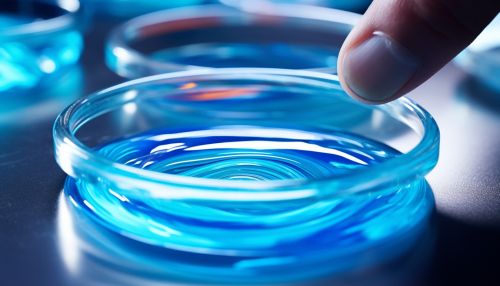Gels
Introduction
Gels are a type of soft material that exhibit both solid-like and liquid-like properties. They are formed through the process of gelation, which involves the interlinking of small particles or molecules into a three-dimensional network. This network is capable of trapping large amounts of liquid, leading to the unique properties of gels.
Structure and Composition
Gels are composed of a solid three-dimensional network and a liquid component. The solid network is typically made up of polymer chains or small particles that are cross-linked together. This network is capable of trapping a large amount of liquid, which can make up the majority of the gel's volume. The liquid component of a gel can be water, oil, or any other suitable solvent.


Types of Gels
There are many different types of gels, which can be classified based on their composition, structure, and properties. Some common types of gels include:
Hydrogels
Hydrogels are gels in which the liquid component is water. They are often used in medical and biological applications due to their biocompatibility and ability to absorb large amounts of water.
Organogels
Organogels are gels in which the liquid component is an organic solvent. They are often used in pharmaceutical applications for the delivery of lipophilic drugs.
Xerogels
Xerogels are gels that have been dried to remove the liquid component, leaving behind only the solid network. They are often used in materials science and engineering applications due to their high porosity and surface area.
Aerogels
Aerogels are a type of xerogel that have been dried under supercritical conditions, resulting in a material with extremely low density and thermal conductivity.
Properties of Gels
Gels exhibit a unique combination of solid-like and liquid-like properties, which can be tailored by adjusting the composition and structure of the gel. Some key properties of gels include:
Mechanical Properties
Gels are soft and deformable, but also exhibit a degree of elasticity due to the presence of the solid network. The mechanical properties of gels can be characterized using techniques such as rheology.
Swelling Properties
Gels are capable of absorbing large amounts of liquid, leading to significant increases in volume. The swelling properties of gels are important for many applications, such as drug delivery and tissue engineering.
Optical Properties
Many gels are transparent or translucent, due to the similar refractive indices of the solid and liquid components. The optical properties of gels can be exploited for applications such as sensors and optical devices.
Applications of Gels
Gels have a wide range of applications in various fields, including:
Biomedical Applications
Gels, particularly hydrogels, are widely used in biomedical applications due to their biocompatibility and ability to mimic the properties of biological tissues. They are used in drug delivery, tissue engineering, wound healing, and as components of medical devices.
Industrial Applications
Gels are used in a variety of industrial applications, including as thickeners in food and cosmetic products, as absorbents in diapers and sanitary products, and as components of paints and coatings.
Scientific and Engineering Applications
Gels are used in scientific and engineering applications such as materials science, chemical engineering, and environmental science. They are used in the fabrication of sensors, actuators, and other devices, and as materials for studying the properties of soft matter.
